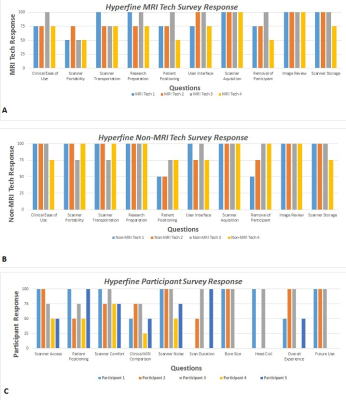S60
Usability Comparison of a Portable Low-Field, Point-of-Care MRI Scanner with High-Field MRI1Radiology, University of Pennsylvania, Philadelphia, PA, United States, 2Hyperfine Research Inc, Guiford, CT, United States
Synopsis
The purpose of this study is to evaluate the usability and acceptability of a newly developed low-field (64 mT), portable, point-of-care (POC) MRI scanner in comparison to standard clinical high-field (1.5 and 3T) imaging from both a patient and operator perspective. Standard MRI units are expensive and technically challenging to install, maintain, and operate and can be difficult for some patients with sensitivity to noise or claustrophobia. Based on our early experience, we find that the experience of POC MRI can be acceptable and preferable to patients as well as operators, including personnel without a technical background in MRI.
Background
Magnetic Resonance Imaging (MRI) has greatly advanced since first introduced as a clinical diagnostic modality in the early 1980s, with a general trend of increasing magnetic field strength, resolution, and technical sophistication. Most imaging is currently performed on high-field (>1.0T) whole-body scanners1 in hospitals or dedicated outpatient imaging facilities by trained certified MRI technologists. Higher field strength 7T scanners are even now in use for select clinical applications. However, high field strength scanners are expensive and technically challenging to install, maintain and operate, and can be difficult for some patients due to body habitus, sensitivity to noise, or claustrophobia. Imaging at low (<0.5T) and medium (0.5–1.0T) field strength remains a viable option in some imaging centers and physician’s offices with advantages including lower cost, smaller footprint, open configuration, and potential artifact reduction. Recent advances in hardware and computational technology along with growing markets for MRI in the developing world have created interest in the topic of low-cost and more accessible MRI scanners.2 Here we describe our early experience on the acceptability (from a patient perspective) and usability (from an operator perspective) of a newly developed low field (64 mT), portable, point-of-care (POC), MRI scanner in comparison to clinical high-field MRI in an outpatient setting.Methods
Patient participants (N = 5) underwent low-field MRI on a portable, POC, 64 mT unit (Hyperfine, Guilford, Connecticut, USA) on the same day as routine clinical MRI as part of an on-going institutional review board-approved clinical trial of outpatients with known or suspected hydrocephalus. Participants were positioned on a hospital bed in a patient consultation room and assisted in sliding their heads into the adjacent POC scanner. MRI sequences included T1-weighted, T2-weighted, fluid attenuated inversion recovery, proton density-weighted, and diffusion-weighted imaging with a total scan and reconstruction time of 40-50 minutes. Participants subsequently completed a survey to compare the experience to their clinical high-field (Siemens 1.5T Aera; Siemens 3T Verio) MRI exam. Participant surveys used a 5-point rating scale (1=least favorable, 5=most favorable) to address the following questions: scanner access; positioning and comfort; scanner noise; scan duration; and bore and head coil size. Scanner operators consisted of MRI certified technologists (N=4) and non-MRI (N=4) personnel trained on the POC system prior to study start-up. Operators used a wirelessly connected tablet computer (Apple iPad) to run the scanner, registering each patient and queuing up the set of sequences above. Scanner calibration, shimming, localizing and slice planning are all performed automatically with this unit. Scanner operators completed surveys with a similar 5-point rating scale to assess patient positioning, scanner preparation, scanner portability and storage, scanner acquisition, image review, and user interface. Survey results were analyzed and reported as average percent positive rates for the low-field scanner, where a 1 on the Likert scale corresponded to 0%, 3 corresponded to 50% and 5 corresponded to 100%.Results
In all categories except one, the majority of participants favored the low-field scanner. Figure 1 presents responses from the survey. For overall experience, participants provided a positive rate of 65% for the low-field scanner in contrast to a traditional 1.5T or 3T clinical brain MRI scan. The POC scanner received a favorable score of 85% for both scanner noise and scanner comfort categories in comparison to its high-field counterparts. Other categories with positive participant feedback included scanner access and positioning having a 75% positive rate for the POC scanner. Head coil size appeared to be the only limitation (40% positive rate), primarily caused by some participants having a ventricular shunt present due to their hydrocephalus diagnosis. For operators, overall user experience and scanner portability were rated favorably (MRI technologists: 84% positive rate; non-MRI technologists: 91% positive rate for the POC scanner). Both groups provided a 94% positive rate for the POC unit on scanner storage along with a 100% positive rate in image acquisition and image review categories, demonstrating the user-friendly operator capabilities of the portable system.Conclusion
Results were promising with the portable POC MRI scanner being considered an easily accessible and acceptable imaging device for neuroimaging from both the participant and MRI operator perspectives in an outpatient setting. More generally, scanner portability with transport of the system directly to the bedside may provide new opportunities for MRI in unconventional locations such as intensive care units, emergency rooms, ambulances, and rural communities with limited medical access.3 Our early experience, including the positive usability results for operators without technical MRI training speaks to the possibility of expanding the use and availability of MRI diagnosis in existing and new patient populations and settings.Acknowledgements
We would like to thank our study participants and acknowledge the support from the Neuroradiology Research Division, and the Center for Health, Devices, and Technology at the University of Pennsylvania.References
1) Campbell-Washburn AE et al; "Opportunities in Interventional and Diagnostic Imaging by Using High-performance Low-Field Strength MRI". Radiology (2019).
2) Wald LL et al; "Low-Cost and Portable MRI". ISMRM (2019).
3) Cooley CZ et al; "Two-dimensional imaging in a lightweight portable MRI scanner without gradient coils". Magn Reson Med (2015).
